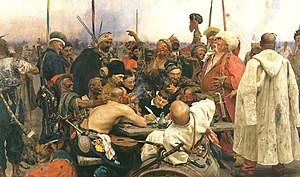Crimean Campaign (1675)
Script error: No such module "Draft topics". Script error: No such module "AfC topic".
| Crimean Campaign (1675) | |||||||
|---|---|---|---|---|---|---|---|
| Part of Cossack-Tatar Conflict | |||||||
 Reply of the Zaporozhian Cossacks | |||||||
| |||||||
| Belligerents | |||||||
|
| Template:Country data Crimean Khanate | ||||||
| Commanders and leaders | |||||||
|
| Template:Country data Crimean Khanate Selim I Giray | ||||||
| Units involved | |||||||
|
| Template:Country data Crimean Khanate Crimean Tatars | ||||||
| Casualties and losses | |||||||
| unknown | 4,000 killed, 23,000 captured | ||||||
Template:Cossacks The Crimean campaign (1675 ) was a campaign of Zaporizhzhia Hetman Ivan Sirko against the Crimean Khanate that ended in a decisive defeat of the latter and the Khan's escape. A detailed description of the events is provided in the chronicle by Samoilo Velychko.
Campaign[edit]
In July 1675, Ivan Sirko returned to the Zaporozhian Sich from the Right Bank Hetman Petro Doroshenko and organised a campaign supported by the entire army to the Crimean Khanate in revenge for all that the Tatars had done.
After three weeks of material and military preparation for the campaign, it was organised to last two weeks. Gathering an army of twenty thousand men and choosing his right-hand man, Ivan Sirko bypassed Perekop and moved south into the steppe, making sure that the Tatars wandering there did not track his army and report to the Crimea.
Having entered the territory of the Crimean Khanate through Syvash, Ivan Sirko and his corps of 3-4 thousand Cossacks penetrated the middle of the peninsula across the Rotten Sea without initiating any hostilities, as his goal was the capital of the Crimean Tatar state, Bakhchisarai, which was also the industrial centre of the country.
There, he divided the army into several corps, appointed a commander for each, and ordered them to mercilessly destroy the Crimean Khanate, dispersing in all directions, and return to the Sivash Strait in five days.
When the Crimean khan learned of the Cossacks' presence, he fled to the mountains with his retinue. Some Tatars followed his example, while others ran to the strong fortifications. According to the chronicle of Samiylo Velychko, most of the remaining Tatars were killed.
Later, some of the Cossacks went to the tributary with the loot, while others, deceptively waving Tatar flags, went after his head.
Having gathered an army of survivors, the Tatar ruler rushed to battle against Ivan Sirko. In the fierce battle, he lost about 4000 killed. Seeing the Cossacks waving Horde flags behind him, the unsuspecting khan believed in their help and boldly moved into the fierce battle. Recognising his men, the ataman faced the enemy. Suffering heavy losses in the battle, the deceived khan also saw the Cossacks behind him and, together with the murzas, again fled in the direction of their movement. As a result, several thousand Tatars were killed, the same number were captured, and the khan himself was almost added to the list.
After the victory, the Cossacks reunited into a single group, had a rest, and set off through Kalanchak, the Black Valley, Kachkari, and left the Crimea.
War booty and liberated Christians[edit]
It is reported that the Black Valley was filled with Tatar cattle in a single harness, with the Tatars themselves walking alongside. Seven thousand Christians were freed and twenty-three thousand Muslims were captured.
Ivan Sirko gave the Christians a choice between going to Rus' and going to the Crimea: four thousand chose the former, three thousand chose the latter. Muslims became a commodity that had to sell themselves or be sent to hopeless captivity in Moscow.
Sources[edit]
- 1. Samoilo Velychko's chronicle
- 2. https://web.archive.org/web/20180308232611/http://www.xn----7sbabirvo2ammddtcfe8b2a.xn--j1amh/ua/history/rus-ukraine/kyrym-1675.html
This article "Crimean Campaign (1675)" is from Wikipedia. The list of its authors can be seen in its historical and/or the page Edithistory:Crimean Campaign (1675). Articles copied from Draft Namespace on Wikipedia could be seen on the Draft Namespace of Wikipedia and not main one.

